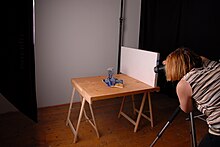Product photography

The product photography (also as object or subject Photography hereinafter) is a major portion of commercial photography , but it is characterized by practicality and realism.
tasks
It is about the appropriate (and that means primarily: sales-promoting) photographic presentation of goods and goods of all kinds, with recordings for product catalogs , brochures , posters , advertisements in magazines and newspapers, commercial supplements , direct mail , flyers , for TV spots and also used on the internet .
techniques
preparation
From the lighting to the perspective to the most advantageous color scheme possible, including choosing the right film material (with a warm or cold base tone or, in digital photography, the correct color balance and white balance ), numerous aspects must be taken into account in order to achieve the most convincing image result possible. In particular, the later purpose of use is in the foreground: A recording for a glossy magazine, for example, has to meet different requirements than one for television. Product images for use on the Internet follow completely their own rules.
layout
Since numerous products such as refrigerators, light bulbs or even machine parts in themselves hardly have any attention value or are not very attractive, their photographic representation often focuses on interesting lighting , possibly with graphic shadows, a surprising perspective and, if necessary, attention-grabbing accessories such as decorations set.
The respective target group also plays a decisive role: When recording for a specialist magazine or a trade fair catalog (or a lexicon such as Wikipedia) that is mostly read by "insiders", the suggestive and persuasive effect of the images is usually not in the foreground. but their factual information content. The transition from documenting object photography to product photography (and from this to artistic still life or to advertising photography) is fluid, as already indicated above.
Photomontage
Product photos, especially those with an advertising character, are often associated with various scenes, environments and local colors, for example by means of photo montage , which can often even come to the fore as image content in order to give the product itself a certain image : The Cowboy in front of the sunset in the prairie (known from cigarette advertising) or an almost unreally sunny sandy beach with an antique marble statue in magazine advertisements for a Greek brandy are examples of this.
illusion
Sometimes potential consumers are even deliberately deceived about the product itself. As is often the case in food photography: Since many dishes after their preparation would not be durable or pleasant to look at long enough before the pictures were taken, models and mockups made of plastic foams and expanded polystyrene take their place, sometimes with great effort by experts ( Food stylists ). This is also the reason why amateurs hardly manage with their resources to take such successful and “appetizing” photos - as seen in cookbooks, for example.
Methods
Tabletop photography plays a prominent role in the production of product photos . The technique of clipping is also important here .
image editing
Today, digital image processing is an integral part of the work of every professional product photographer in the context of post-production. It has found widespread use in product photography over the past two decades. This led to an enormous upswing, which is not least reflected in the large number of service providers that offer themselves in this area.
The modern means of image processing allow the photographer to perfect his pictures. So after the camera recordings z. B. Impurities, scratches or other interferences on the product can be eliminated. With the appropriate software, the product photographer also has complete control over all relevant parameters that influence the effect of the final image. These are, for example, sharpness, contrast, brightness and saturation. The technique of cropping and the use of masks, which enable the partial processing of images, are also important here.
Well-known photographers
The German photographer Albert Renger-Patzsch , who worked for Pelikan and the Jenaer Glaswerke , among others, set standards in property and product photography .
Peter Belanger is one of the icons of modern product photography. The American advertising photographer stages products at the very highest level. His customers include Apple, Nike, Sony and Adobe, among others.
literature
- Axel Larg, Jane Wood: Modern Product Photography. Laterna Magica, Munich 1999, ISBN 3-87467-751-6
- Eberhard Schuy: Object photography : from object photography to staged product photography. dpunkt.verlag GmbH, 2014, ISBN 3-86490-200-2
- Eberhard Schuy: Object photography (digital photography). Markt + Technik Verlag, 2012, ISBN 3-82724-772-1
- Eberhard Schuy: Object photography in detail: pictures, sets and explanations (Pearson Photo). Addison-Wesley Verlag, 2012, ISBN 3-82733-203-6
- Eberhard Schuy: Object photography in detail - pictures, sets and explanations (DPI photography). Addison-Wesley Verlag, 2009, ISBN 3-82732-885-3
- Oliver Feld: Professional product photography (with edition Profifoto). mitp, 2012, ISBN 3-82665-078-6
- Roger Hicks, Frances Schultz: Product Photography. Motif, design, light. Laterna Magica, Munich 1999, ISBN 3-87467-695-1